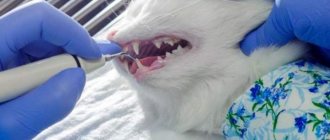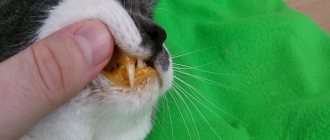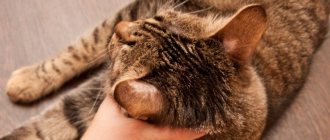In apartment cats, tartar often forms - a calcareous deposit on the base of the tooth, almost at the very gum. First, a soft coating appears, then, if it is not removed, it thickens and becomes stone-like. The animal cannot get rid of it on its own, especially if it receives soft food.
The process of mineralization (stone formation) itself is painless and does not bring any unpleasant sensations to the cat, but if measures are not taken in time, big problems can arise, including sepsis. Pet owners regularly ask specialists questions about how tartar is removed from cats and how to prevent its occurrence.
What is tartar
The growth of stones is provoked by ossified remains of food, saliva, putrefactive bacteria, and minerals contained in water. All this enters into a violent chemical reaction with each other. Depending on the location of the formation, there are:
- supragingival;
- subgingival.
The first can be seen in the area of the canines, incisors and premolars. The plaque has a light yellow tint, which gradually darkens and turns brown. The subgingival is located on the very neck of the tooth, in a pocket under the tissues. It is impossible to recognize subgingival tartar in the photo.
What does tartar look like?
The tartar on cats' teeth is a colony of microorganisms. Essentially, it is a ossified plaque on the outside of the teeth.
It includes traces of food, bacteria, dead cells, as well as calcium, phosphorus, and iron salts. What does he look like? Visually, this is plaque or crusts at the base of the animal’s teeth. The color can vary from yellowish to dark brown. It is important to remember that a cat’s tartar is located not only on the visible part of the tooth, but also under the gum. Therefore, diagnosis is often difficult.
Why is it dangerous?
Veterinarians warn that if tartar is not treated in time, the animal may not only lose a tooth, but also die.
The main danger is that the stone on the cat’s teeth grows, forming a pocket in the animal’s gum. Gingivitis, caries, periodontitis, periodontitis, osteomyelitis, fragility of teeth, pulpitis, stomatitis - an incomplete list of diseases resulting from the spread of tartar.
The consequences of these diseases: inflammation, abscesses and fistulas of the gums, the formation of ulcers, swelling, loosening of teeth and their loss, enlarged lymph nodes. As a result of swelling and ulcers on the mucous membrane of the mouth, the cat cannot eat and swallow food normally, which leads to diseases of the stomach and intestines. In addition, inflammation can spread from the mouth to the ear, causing otitis media.
The greatest danger lies in purulent processes that can affect the brain or spread through the bloodstream. In such cases, the animal dies.
Terms of education
The first signs of tartar can be noticed in young cats that are not even a year old, especially if we are talking about purebred representatives. It is known that among elite cats, tartar is more common. On average, the age when pathology becomes obvious is 4-5 years.
Factors influencing the rate of tartar formation in cats:
- poorly prepared diet, especially food from the common table;
- improper bite aggravates problems, making natural self-cleaning impossible;
- nutrient metabolism disorder;
- lack of access to quality drinking water;
- lack of oral hygiene.
Perhaps the first and last points are the most important in this matter. Without regular brushing of teeth, and even with poor nutrition, the cat runs the risk of acquiring stones at a fairly young age.
At-risk groups
Some breeds of domestic cats have a genetic tendency to develop plaque. These include Siamese, British, Scottish fold and Persian individuals.
Also at risk are animals that eat exclusively soft homemade food and do not receive oral care.
How is it formed in a cat?
Plaque on the teeth does not begin to harden immediately; the process takes several months. What stage of formation the deposits are at can be recognized by their shade:
First, food residues and polysaccharides settle on the teeth, in which microorganisms begin to actively multiply. Plaque is fixed through adhesion. At this stage it is still soft, yellowish in color.- Over time, the formation is covered with a film of glycoproteins, protecting the deposits from salivary enzymes. The coating gives the teeth a brownish color.
- Under the influence of bacteria trapped under the film, chemical and physical liming processes develop. As a result, the plaque hardens, turning into stone, and acquires a brown tint (in the presence of pyogenic pathogens, it may be green).
Accumulations accumulate to a greater extent on the front side of the teeth - on the inner surface, plaque is almost completely scraped off by dense pieces of food that the cat gnaws.
How serious is the problem?
Some pet owners perceive colored crowns as a cosmetic defect and are not too worried about it.
This happens due to ignorance of the dangers of limestone. Plaque does not destroy dental tissue, but it causes a lot of other troubles. An infection develops in the oral cavity, affecting the soft tissue of the alveoli and the gum mucosa.
Growths on the crowns cause mechanical irritation on the inner surfaces of the lips and cheeks, causing discomfort in cats while eating food (and not only).
As the formation grows, it penetrates under the gum, becoming the cause of gingivitis, periodontitis and other dental diseases. This causes not only an unpleasant odor from the pet’s mouth, but also leads to brittle teeth.
If you do not pay attention to the growth of stones, the cat may develop ulcers, fistulas, and abscesses on the gums. The lesions quickly grow and gradually move into the ear canals, as a result of which the animal develops otitis media.
Inflammation in the oral cavity prevents the cat from eating, and this leads to diseases of the gastrointestinal tract.
Gradually, the processes enter the purulent phase, and these accumulations spread throughout the body through the bloodstream. Having reached the brain, pus provokes death.
Reasons for fossils
Dental problems can be caused by the following factors:
- lack of timely hygienic treatment of the oral cavity;
- trauma, extensive deep caries, gum damage;
- the absence of a neighboring tooth on the opposite jaw, which provides friction when chewing food;
- malocclusion or curvature of the jaw bones;
- metabolic disorders in the animal's body;
- incorrectly selected diet;
- drinking tap water.
If your cat is at risk, do not neglect preventive visits to your veterinarian.
How long does it take to form
An unpleasant plaque on the teeth can also be found in a kitten, because its diet does not yet contain solid food that would help clean off the stone. The pathology will truly manifest itself only after 4 years, when removing lime deposits will be problematic.
Not only genetically predisposed breeds are at risk, but also old or sick animals.
Options for placing stone on teeth
If you just look into a cat’s mouth, you can’t always immediately notice the problem, not knowing where to look for it. There are 2 options for the formation of stones on teeth.
Types of pathology
| Stone | Peculiarities |
| Supragingival | It is mineralized dental plaque. It is freely separated from the enamel, but, having a porous-rough surface, it is the basis for subsequent layers. Depending on the composition, it has a yellowish or brown tint. |
| Subgingival | The stone can only be detected by sanitation of the cat’s oral cavity by moving the gum away from the tooth with a dental instrument. Dark brown or black layers cover the neck of the tooth in a dense ring. The main content of the stone is hardened gingival fluid or plasma proteins |
If the formation of stones on the open surface of the tooth is associated with external factors and the composition of saliva, then growths hiding in “pockets” are a consequence of deviations in the biochemical composition of the blood serum. Therefore, this option cannot be eliminated only by hygiene procedures and a change in diet.
Early and late stage symptoms
You can determine whether your pet suffers from tartar plaque on their teeth by a number of symptoms:
- a strong putrid odor emanates from the animal’s mouth even at the initial stage;
- on the base of the tooth, near the gum itself, a dark plaque is visible to the naked eye, the shade of which can reach brown in advanced cases;
- the gums are red and inflamed and begin to bleed at the slightest contact with food;
- hypersalivation is noted - excessive secretion of saliva, it occurs at any stage of the disease;
- unstable position of teeth, sometimes – their loss;
- swelling of the animal's oral mucosa;
- behavior that is unusual for an animal while eating - restlessness, attempts to move away from the bowl and immediately return to it, dissatisfied growling, strong slurping;
- complete refusal of solid food;
- scratching cheeks on corners of furniture.
It is worth remembering that some symptoms individually may be manifestations of another disease. For example, bad breath often characterizes a malfunction of the gastrointestinal tract or the development of cancer (in this case, the smell has a putrid-sweet character). Rubbing the muzzle against a surface may indicate an allergic reaction or the presence of ear mites.
Symptoms
It is quite easy to identify the symptoms.
When examining the oral cavity, inflammatory processes are observed on the gums, characterized by redness, swelling, and pain.
Yellow plaque on a tooth is a clear sign of tartar formation.
- The presence of an unpleasant odor from the animal's mouth.
- Yellow or brown plaque at the base of the fangs, the entire jaw - depends on the degree of damage.
- The cat's anxiety while eating, its nervousness, cautious approach to food.
- Complications in the form of growths, neoplasms, and tumors of the mucous membrane are possible.
- Bleeding gums indicate the presence of periodontal disease.
The advanced form increases the risk of gingivitis, and subsequently stomatitis . If an animal frequently shakes its head, this means that there are complications in the form of developing diseases of the ears and nasolacrimal ducts.
Constant pain may indicate pulpitis - inflammation of the dental nerve.
Diagnosis of pathology
If you notice alarming symptoms in your furry friend, you should be wary. These phenomena in a cat can be symptoms of both tartar and other dental diseases.
To make sure that the problem is indeed fossilized plaque, you can perform the following test. To do this, just moisten a cotton swab with Lugol's solution or iodine (5%) and rub your teeth with it, grabbing the gums adjacent to them. After performing this manipulation, the stone is clearly visible.
The plaque on the enamel may be removed after such a procedure, but the supragingival stones will remain and acquire a dark brown color. However, this method is suitable for identifying only supragingival stone. The subgingival calculus will be detected by the dentist during an examination.
It is best to entrust the diagnosis of the presence of tartar in a cat to a veterinary dentist. This is a narrow specialist with extensive experience. The examination is carried out using a special dental mirror: the mucous membrane of the cheeks and tongue is carefully checked for the presence of ulcers and lesions, and the condition of the teeth and gums is assessed.
Possible complications
Tartar is a health hazard for your cat. As mineral deposits grow, they form a dental pocket and cause gum irritation.
In addition, it contributes to the appearance of dental diseases such as gingivitis, caries, periodontitis, periodontitis, osteomyelitis, which, in turn, cause not only loosening and loss of teeth, but also purulent processes, sepsis, which create dangerous preconditions for death.
Methods of treatment at the veterinary clinic
The treatment procedure involves removing mineral residues. At an early stage of the disease, it is possible to help the animal yourself, but if the plaque has hardened, removal must be carried out in a clinic.
Using special tools and a scaler
Tartar cleaning in a veterinary clinic is done in two ways:
- mechanical;
- using ultrasound.
The first method of treatment is currently rarely used. During the procedure, plaque is removed using special dental instruments. The effect is short-term, since only those stones that are visible to the naked eye are removed, and the gum pockets are not affected.
Since tooth enamel is rough and uneven, the problem returns quite quickly. During mechanical cleaning, there is a high risk of traumatizing the enamel, which can lead to the appearance and spread of caries, as well as pain in the animal.
Often, the doctor touches the mucous membrane and gums, creating scratches that become inflamed when bacteria enter them. The manipulation is performed without anesthesia. The advantage is the low price.
Ultrasonic cleaning
Tartar removal using ultrasound is performed only under general anesthesia, which is a significant disadvantage, despite the effectiveness of the procedure. This method allows you to completely clean the tooth surface without causing any discomfort to the animal.
The ultrasonic wave changes the structure of the deposit, making it looser, after which it peels off. The enamel and mucous membranes are not affected. After the procedure, the teeth are polished and fluoridated. The smooth, protected tooth surface prevents food debris and minerals from clinging to it.
In some cases, when there is a high risk of complications from anesthesia, the ultrasound procedure is performed without it using sedatives. It is prohibited to use anesthesia in older animals or with diseases of the cardiovascular and genitourinary systems.
Treatment method and prognosis
Tartar removal is carried out in a veterinary clinic. The procedure is performed under general anesthesia. The duration of the operation is 1 hour.
Two methods are used to remove mineralized deposits on the surface of teeth - ultrasonic and mechanical.
For mechanical cleaning, dental instruments are used and it is carried out manually. The procedure is inexpensive, but has a significant drawback - possible damage to the enamel. That is why veterinarians recommend mechanical removal only in cases of complete contraindication to general anesthesia.
The ultrasound method is a modern and absolutely painless procedure performed using special equipment. Ultrasound is able to cope with the hardest calcareous deposits, peeling them off from the tooth tissue.
During the procedure, not only plaque is removed, but also pathological microorganisms are destroyed, periodontal pockets and interdental spaces are cleaned. The method is absolutely safe, since the enamel is not damaged, and anesthesia is used only to immobilize the pet.
Since after brushing the teeth, the enamel acquires a rough surface, which creates the preconditions for the re-formation of stone, polishing is necessary. Ideal enamel smoothness is achieved using special pastes and brushes.
Fluoridation (applying a special varnish or gel with sodium fluoride to the teeth) is a desirable, but optional step in cleaning tartar. With this procedure, tooth hypersensitivity is reduced and the enamel is strengthened, making it less vulnerable to caries.
Removing stones at home
Weak and loose plaque can be removed independently. The most difficult thing in this matter is to cope with the cat, which clearly will not like this procedure.
Special treats and dry food
At the moment, pet supply stores offer a fairly wide range of special treats. The principle of their operation is to soften when exposed to saliva. The consistency of the hard treat becomes like plasticine. It is recommended to treat your pet to such a delicacy at least twice a week.
Veterinary feeds have a special composition and structure of granules. Unfortunately, they cannot remove tartar, but they can remove plaque.
Toys designed to clean a cat's mouth are impregnated with catnip. They have a rough surface that polishes the teeth when the cat bites into the item.
Veterinary wipes
There are many home remedies for removing tartar in cats. One of the most popular is veterinary wipes. Typically, they are soaked in a solution containing baking soda and peppermint.
Wipes have an antimicrobial effect and are also able to soften loose stone (at its initial stage). The principle of operation is very simple - take a napkin, wrap it around your finger and wipe your pet’s teeth.
Of course, it will not be possible to completely remove tartar at home, but this remedy has proven itself to be effective as a preventive measure.
Special means
You can try to remove tartar in cats using special products that soften the plaque and allow you to remove it with a brush or scaler. One of the most popular folk remedies is hydrogen peroxide. It can remove plaque from your teeth, but you must be careful not to touch your gums. Take a cotton swab, moisten it with peroxide and treat the tooth where plaque is visible.
To soften plaque, you can use a variety of gels, pastes and sprays from a veterinary pharmacy. They are applied to cats' teeth using a dispenser. Over time, the stone “moves away” from the tooth enamel.
Not all animals allow you to brush your teeth. In this case, liquids will help - you can add them in the form of drops to a bowl of water. There are also products for oral administration. Tartar under the influence of the product becomes porous, loosens, and can be easily removed from the surface of the teeth - just let the cat chew on a special treat or dry food.
Mechanical cleaning
You can remove plaque at home, but you need to have the skills to work with a scaler. The plaque is pre-softened with a special product from a veterinary pharmacy or hydrogen peroxide. You need to use peroxide as carefully as possible - you need to apply it so that it does not get on your gums. A cotton swab is generously moistened with the solution and applied to damaged teeth.
Next, the scaler is carefully passed from the base of the tooth, that is, from the gums, downwards, scraping off plaque. You need to be very careful not to damage the delicate mucous membranes. In this case, it is better to enlist the help of a relative: one will hold the cat, and the second will carry out the procedure.
After completing the manipulation, it is advisable to treat the pet’s mouth with a weak chamomile decoction. If you have never removed plaque yourself, you can consult a veterinarian about this.
Predisposition and risk groups
It is noted that among purebred cats there is a higher risk of developing tartar.
This is due to the dishonesty of many breeders, who ignore the signs of breeding marriage and congenital diseases that are inherited.
These are the breeds that are in greatest demand: Persian, British, Scottish, Siamese, Thai.
Prevention and oral hygiene
Treatment of tartar in cats, regardless of the method chosen, is an unpleasant procedure for the animal. That is why it is worth paying great attention to the prevention of plaque formation.
For this you can use special gels and pastes. This method is considered chemical, but completely safe for cats. It can be used both to remove primary, not yet fossilized plaque, and to prevent disease. The gel not only softens deposits, but also fights bacteria, destroying pathogenic microflora.
It is worth remembering that half an hour before cleaning the animal should not be fed; it is recommended to remove the water bowl for a while. To prevent contamination, brush with cat toothpaste at least twice a week.
Tartar is a common problem for a large number of cats and their owners. You cannot put off going to the veterinary clinic. The development of the disease can lead to inflammation, which will spread to other systems and organs. Brushing your teeth and proper feeding is a reliable prevention of dental problems.
The article is for informational purposes only. Contact your veterinarian!
Preventive measures
It is recommended to visit the veterinarian once every six months so that he can examine the animal’s oral cavity for the formation of tartar. If it is not possible to visit a veterinary clinic, you need to regularly examine your pet yourself.
Timely cleaning of teeth from plaque (about once every 5 days) can significantly reduce the risk of tartar formation. It is recommended to introduce the animal to this procedure from a very early age so that its indignation does not interfere with cleaning.
There are a variety of toothpastes and brushes on the market that are made specifically for cats, but you can simply use your index finger to clean the plaque off your teeth.
Regular dental examination and brushing are the most effective means of preventing dental plaque.
The food your cat eats should contain tough ingredients and grass. There are foods on sale that contain special granules that clean the surface of the teeth mechanically and contain polyphosphates; they settle on the teeth and prevent the formation of plaque. Taking multivitamins helps maintain dental health. And by allowing your cat to chew on cartilage, chicken necks, or letting you play with a toy, you will reduce the likelihood of plaque on your teeth to a minimum.
If an animal has digestive diseases, they should be treated in order to restore the chemical balance in the mouth and thereby reduce the risk of tartar formation.
Video: how to properly brush your cat's teeth
Prevention
The condition of your pet’s oral cavity must be monitored from an early age.
- Give solid food and treats that promote self-cleaning of the enamel, and after 4-5 years, special food. Dried tendons have proven themselves very well. In summer you can give your cat grass.
- Clean your pet's teeth daily.
- Give someone special vitamins in courses.
- Visit the dentist once every six months for preventive sanitation.
- Monitor the condition of the cat’s stomach, liver, kidneys and acid-base balance.
How is a tumor removed in veterinary clinics?
Clinics have special tools for removing tartar from the teeth of four-legged patients. The procedure itself is unpleasant and painful, so it is often performed under general anesthesia in a clinic setting.
Before choosing a stone removal method, the doctor determines where it is located. You can get rid of the formation mechanically or using ultrasound.
Mechanical chipping is performed with a special dental blade - a skeller. The surface of the units is first treated with lactic acid so that the stone comes off better. When manually removed, there is a risk of accidentally damaging the gums or compromising the integrity of the tooth surface. For this reason, ultrasonic cleaning is preferable.
This procedure can last from 40 minutes to several hours. Before surgery, the animal should not be fed for 12 hours. Cats aged 5 years and older need to undergo a preliminary examination to make sure that the anesthesia will not harm their body.
The animal is fixed in a lying position and the mouth is treated with iodine solution: this helps to remove saliva from the surface of the teeth. After this, the enamel is polished with ultrasound. The treated areas after such an operation are lubricated with an antiseptic.
The first days after ultrasonic cleaning, the animal may experience discomfort and pain. In this case, the veterinarian will prescribe him a painkiller. After surgery, your pet should be fed warm, semi-liquid food.
Plaque prevention
As for preventive measures, it is enough to follow simple rules so that you will never again wonder how to remove tartar at home. Proper care includes the following:
- Complete cessation of unhealthy habits. We are talking about smoking, consumption of excessive amounts of sweets, coffee and black tea that affect dental health.
- Quality food. Regular consumption of fresh vegetables, herbs and dairy products helps cleanse the enamel.
- Purchase a new toothbrush every month.
- Regular visits to the dentist. It is recommended to visit a dentist once every six months.











